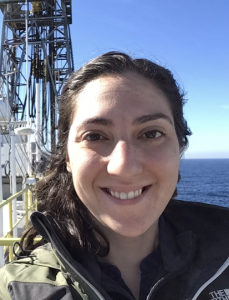Samantha Bova
San Diego State University
2021-2022 Distinguished Lecturer
It’s getting hot in here: Reinterpreting climate proxies alter understanding of interglacial warmth
Predicting the response of Earth’s climate system to rising global temperatures is one of the grand challenges facing the scientific community today. Scientific ocean drilling has been at the forefront of this challenge for decades enabling the collection of sedimentary archives that offer a perspective on Earth’s climate during previous interglacials unaffected by human activities. Paleoclimate records, such as these, are the only way to observe the response of Earth’s climate system to warmer than present temperatures.
The Holocene and last interglacial thermal maxima, occurring approximately 10 to 6 and 128 to 123 thousand years ago, respectively, are the two most recent warm intervals in the geologic record and are often used as analogs of future climate. This is because proxy reconstructions, arguably interpreted to record global mean temperatures, indicate these periods were as warm or warmer than recent decades. However, early interglacial warmth is not simulated in the annual mean by state-of-the-art climate models. This model-data inconsistency thereby limits our understanding of both the cause and climate system response of the observed warmth, and thus the utility of these time intervals to help predict our future.
Using sediments collected off the north coast of Papua New Guinea on IODP Expedition 363 and a suite of sediment cores recovered on previous ocean coring expeditions, I will demonstrate that early interglacial warmth, as recorded by proxies, is a seasonal feature driven by changes in incoming northern hemisphere summer solar radiation, and that peak mean annual global temperature actually occurs thousands of years later. This result confirms climate model simulations that show global mean annual temperature warming, rather than cooling, across past interglacial periods, and thus resolves the long-standing interglacial temperature conundrum. The new results show that Earth’s global temperatures have reached uncharted territory that has not been observed over the past 12,000 and perhaps 128,000 years.
Dr. Samantha Bova is a paleoceanographer and paleoclimatologist, meaning she researches how the earth’s climate has changed over time. Her work has been helping to solve a big mystery in climate science about why models of climate change in the past 12,000 years have not always lined up with available temperature data. Dr. Bova attributes her interest in geology and climate to her childhood hobbies of digging for rocks and categorizing seashells and an amazing teacher in her high school geo-environmental class. In her first semester at San Diego State, Dr. Bova is enjoying teaching a class on interdisciplinary climate change solutions and hopes to do more outreach with K-12 students about geology and climate change in the near future.
LECTURE SCHEDULE
- October 1, 2021 – Colby College, Waterville, ME
- October 15, 2021 – University of Texas at Arlington, Arlington, TX
- March 29, 2022 – Dickinson College, Carlisle, PA
- March 30, 2022 – Chesapeake Bay Biological Laboratories UMCES, Solomons, MD







